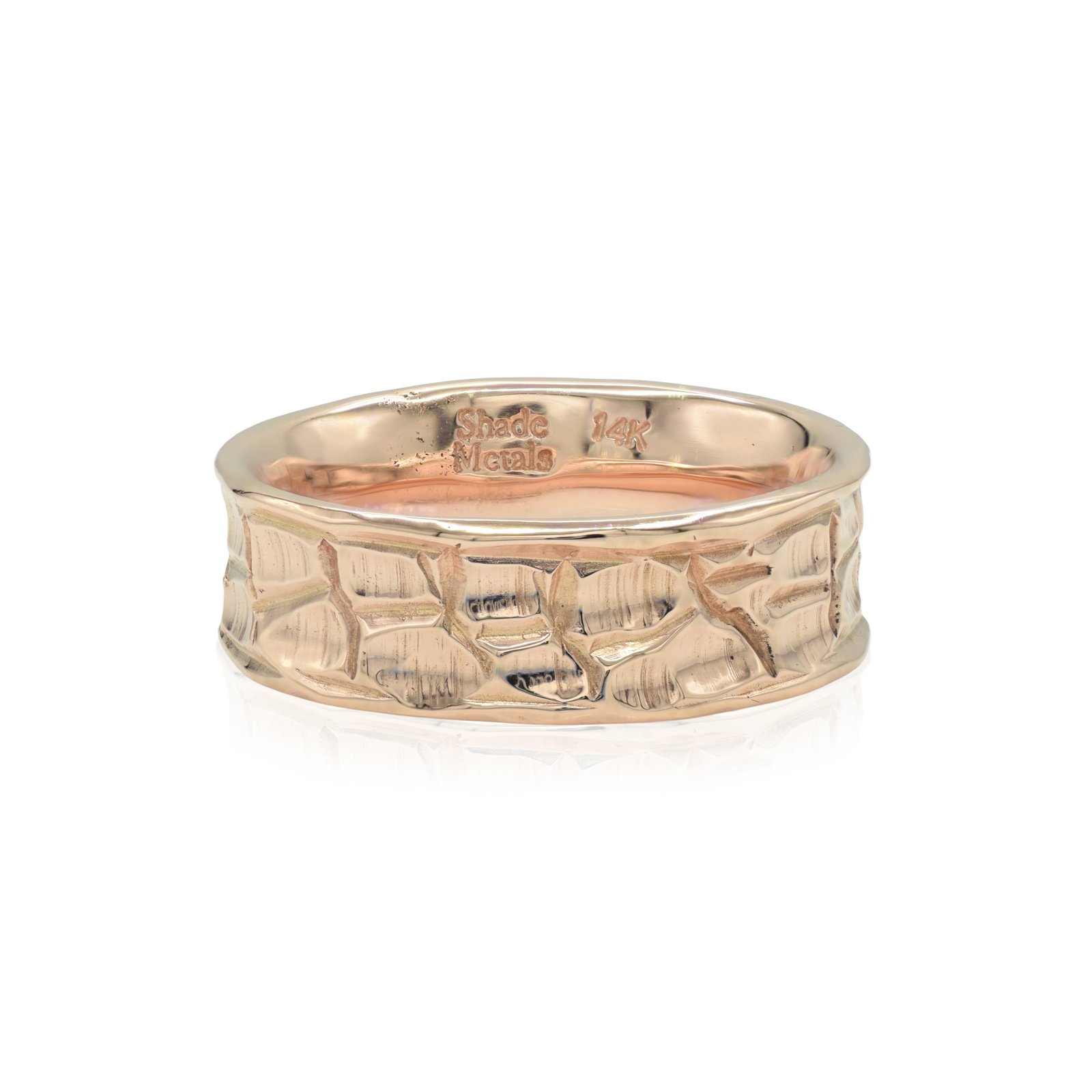 Image 1 of 3
Image 1 of 3

 Image 2 of 3
Image 2 of 3

 Image 3 of 3
Image 3 of 3




Loblolly Bark Ring in 14k Rose Gold | Pinus taeda | Size 6 ½
We carved this ring to mimic the chunky rectangles shapes in loblolly pine bark. According to the US Forest Service this is the second most common species of tree in the US, second only to red maple. It is native to the southeast, from Texas to Florida and up through New Jersey, and is the state tree of Arkansas.
The design is carved into hard wax and cast in 14k rose gold. Rose gold is an alloy of gold with extra copper in it that turns the yellow of gold into a warmer, pinkish color.
14k rose gold
One-of-a-kind carving
Size 6 ½
SHIPS IN 1 - 3 DAYS
***I don't know my ring size*** Fill out this form and we’ll put a free plastic ring sizer in the mail for you today - RING SIZER REQUEST FORM
***Gold Ring Stock***
In general you will only see a few sizes of the gold rings available. We don’t keep a large stock of gold because of the expense, so if we don’t have your size available, please send us a note and we can get to work making one for you. info@shademetals.com
Instagram or Facebook: @shademetals
We carved this ring to mimic the chunky rectangles shapes in loblolly pine bark. According to the US Forest Service this is the second most common species of tree in the US, second only to red maple. It is native to the southeast, from Texas to Florida and up through New Jersey, and is the state tree of Arkansas.
The design is carved into hard wax and cast in 14k rose gold. Rose gold is an alloy of gold with extra copper in it that turns the yellow of gold into a warmer, pinkish color.
14k rose gold
One-of-a-kind carving
Size 6 ½
SHIPS IN 1 - 3 DAYS
***I don't know my ring size*** Fill out this form and we’ll put a free plastic ring sizer in the mail for you today - RING SIZER REQUEST FORM
***Gold Ring Stock***
In general you will only see a few sizes of the gold rings available. We don’t keep a large stock of gold because of the expense, so if we don’t have your size available, please send us a note and we can get to work making one for you. info@shademetals.com
Instagram or Facebook: @shademetals
We carved this ring to mimic the chunky rectangles shapes in loblolly pine bark. According to the US Forest Service this is the second most common species of tree in the US, second only to red maple. It is native to the southeast, from Texas to Florida and up through New Jersey, and is the state tree of Arkansas.
The design is carved into hard wax and cast in 14k rose gold. Rose gold is an alloy of gold with extra copper in it that turns the yellow of gold into a warmer, pinkish color.
14k rose gold
One-of-a-kind carving
Size 6 ½
SHIPS IN 1 - 3 DAYS
***I don't know my ring size*** Fill out this form and we’ll put a free plastic ring sizer in the mail for you today - RING SIZER REQUEST FORM
***Gold Ring Stock***
In general you will only see a few sizes of the gold rings available. We don’t keep a large stock of gold because of the expense, so if we don’t have your size available, please send us a note and we can get to work making one for you. info@shademetals.com
Instagram or Facebook: @shademetals


Bark Patterns
Tree bark patterns are fascinating because they reflect both the tree's biology and its interaction with the environment. Bark serves as a protective covering, helping to shield the tree from pests, diseases, and environmental conditions. The texture and appearance of bark result from the growth and development of the tree's cambium, a layer of tissue beneath the bark responsible for producing new layers of wood and bark annually.
Loblolly pine bark is thick and deeply furrowed, with irregular, elongated plates. The bark tends to become more rugged and deeply fissured as the tree ages.
Why It Forms:
Pines like Pinus taeda produce thick bark as an adaptation to fire-prone environments. The thick plates help insulate the cambium and vital tissues from heat during wildfires.
The deep fissures and rugged plates form due to the tree's rapid growth and the production of large amounts of cork cambium, which adds layers of protective bark.
The pattern can vary depending on environmental stressors, with more rugged bark forming in trees exposed to frequent fires or extreme conditions.
Ecological Significance:
The thick, plated bark provides habitat for insects and small animals.
It plays a key role in the tree's survival in ecosystems where fire is a natural occurrence.
Specific bark patterns optimize the tree’s survival in its particular ecosystem, they are shaped by evolutionary pressures like climate, predation, and competition.

